The Highroad to Orange Land
RAILWAYS OF AMERICA - 10
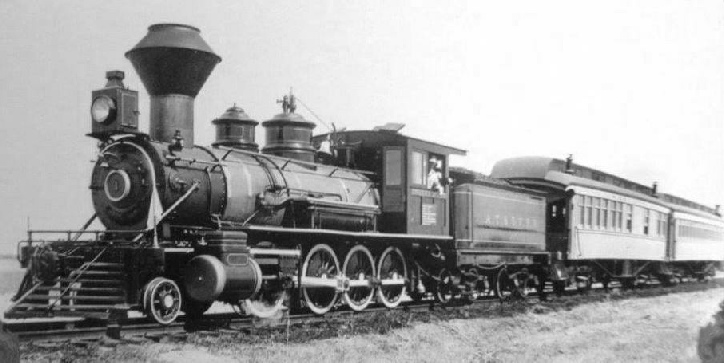
The “Cyrus K. Holliday”, Locomotive No. 1, Atchison, Topeka & Santa Fe Railway
THREE centuries ago the Spanish friars founded a city in New Mexico near a tributary of the Rio Grande, and gave it the imposing title of La Ciudad Real de la Santa Fe de San Francisco, which being interpreted means “The True City of the Holy Faith of Saint Francis”. As the place increased, words were whittled off its name, and to-day only a mere fragment, Santa Fe, survives of that sounding sentence. Many buildings and relics remain of the time when the Holy Inquisition pursued its gentle task among the natives who dwelt within sight of the Rocky Mountains, and when “the mailed warriors of Coronado told marvellous uncontradicted tales of ogres that were believed to dwell in the surrounding wilderness”. The palace still stands in which the first Viceroy held his court, and you may see a hundred and one things to recall the persevering labours of the Spanish fathers among their treacherous and thankless flocks.
In 1680 the natives revolted against the Spaniards and drove them out of the territory. Twelve years later they were subjected again, and the country grew in population and importance until, early in the nineteenth century, its trade with Missouri and the East became valuable. Its climate is cold in the higher regions, hot in the plains, and generally suited for the growing of maize, wheat, fruits, and tobacco, where water can be got in sufficient quantities for irrigation. Under the surface lie rich deposits of gold, silver, copper, iron, and salt, which every year are more extensively mined.
Caravans soon began to trail across the prairies between Kansas and Santa Fe, over the Raton Pass of the Rockies. The distance was 800 miles, and the round trip occupied three to four months.
“Merchandise to an enormous value was often carried by a single caravan. In spite of the protection of a strong military escort the trail was almost continuously sodden with human blood and marked by hundreds of rude graves dug for the mutilated victims of murderous Apaches and other tribes. Every scene recounted by romances of Indian warfare had its counterpart along the Santa Fe trail. The ambush, the surprise, the massacre, the capture, the torture, in terrifying and heart-breaking detail, have been enacted over and over.”
Things were therefore lively on the caravan route during the first forty-five years of the century. In spite of the Apache the caravans pushed backwards and forwards with their precious burdens. But this method of transport became too slow and restricted for the adventurous merchants of the growing Missouri States. Railways were ramifying rapidly, and until the locomotive careered across Kansas, New Mexico, and Arizona, they felt that the resources of these regions were being wasted.
On February 11, 1859, a Company was incorporated under a special Act of the Legislature for the construction of the Atchison & Topeka Railroad. The name of Colonel Cyrus K. Holliday stands out from among many others as that of the man who first realised the immense possibilities of a line across Kansas to New Mexico. While his fellow-promoters were wondering whether the game were worth the candle, Holliday had in imagination got the track across to Santa Fe, with branches north to Denver, eastward to San Francisco, southward to the Californian and Mexican gulfs. Such enthusiasm of course drew on it a large amount of ridicule, but the Colonel had the courage of his convictions; he merely smiled when others mocked, stuck with grim determination to his scheme, and before his death, in 1900, had the satisfaction of seeing nearly all his “dream” materialise into solid fact.
It was largely due to his influence that, in 1863, the name of the Company was extended to “The Atchison, Topeka, and Santa Fe Railroad”. The shareholders now had a better conception of what they should aim at. In the same year Congress gave the road a lift by voting to the proprietors a grant of 10 square miles of territory for every mile of track laid through Kansas to its western boundary, on condition that the road should be completed to the State limit within ten years, viz. by 1873.
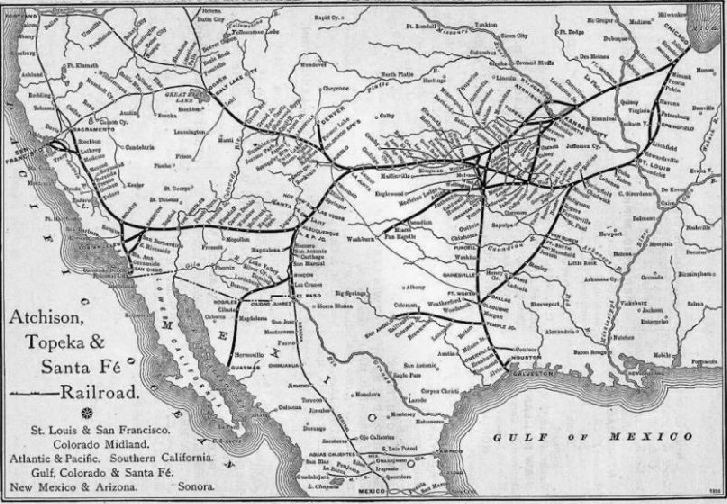
As in the case of the Union Pacific, financiers hung back, and there was not much done except in the way of meetings and efforts at promotion, until July 1869, when the road was constructed from Topeka to Carbondale - so named after the rich coal measures discovered there - a distance of about eighteen miles. Then the faint-heart element prevailed again. Plague and drought were taking toll of the inhabitants of Kansas, few enough already, and it was seriously discussed whether the building of the railroad to the west line of the State, a distance of 300 miles, would result in sufficient immigration to prove a success. A committee of directors travelled by waggons over the contemplated line - which had already been staked out by daring surveyors along the Arkansas River to the Rockies - spying out the land to determine whether they could recommend the investment of money in the scheme. They saw nothing much except prairie grass, but where it grew corn could grow, and with true wisdom they decided that there was sufficient virgin wealth under the buffalo pasture to warrant a forward policy.
On their return home they gave the word for the advance. Only a few years remained to save the Government grant. Though hampered by the usual difficulties of moving material, they rapidly pushed the rail-head westwards over the billowy expanses of Kansas, completing the last stretches of the line at a mileage per day that at the time broke all records and reflected great credit upon the organisation of the Company. As the platelayers advanced hunters got to work among the buffalo herds, slaughtering them in thousands for their hides. Their bones whitened the prairies, and the collection of them for reduction to manure became quite a flourishing industry. Yet even a year after the line had been completed the great beasts were numerous, and at one time the cold north winds drove them from the plains down to the river at Dodge City in such numbers that they actually impeded the passage of the trains. It is very unlikely that the future history of American railroading will ever again witness such a fine opportunity for the “cow-catcher” to act up to its name.
At the boundary line the Company paused for a breathing space, and then attacked the south-eastern corner of Colorado, bending their rails gently to the south-west, through the Raton Pass, which by a bold stroke they occupied just in time to forestall the engineers of the Denver & Rio Grande, who claimed Colorado for their own. The Santa Fe people won the race by a few hours, began shovelling earth at night while their rivals slept, and by dawn had established their rights to possession.
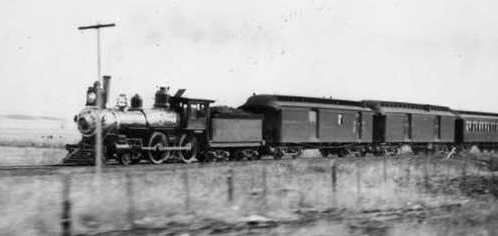
A passenger train on the Atchison Topeka & Santa Fe Railway c1890
Clear of the Pass, the rails run almost due south along the eastern edge of the domain once owned by the American Fur Company. At the New Mexican boundary a tunnel had to be cut, at an elevation of nearly 7600 feet, through half a mile of mountain. From the southern end the track drops by a winding pass into the land discovered by Marcos de Nizza 345 years ago, “above forests of pine and fir; through canyons where fierce rock walls yield grudging passage, and massive grey slopes bend downward from the sky; along level stretches by the side of the Great River of the North, whose turbid stream is the Nile of the New World; past picturesque desert tracts spotted with sage, and past mesas, buttes, dead volcanoes, and lava beds.” In 1878 the first car entered new Mexico; in 1880 the railroad was blowing the whistle of western civilisation outside old-world Santa Fe. The same year the engineers were in Albuquerque, and fifteen months later at El Paso, Texas. By 1883 the Atlantic & Pacific Railway joined Albuquerque with the Pacific, and another through line was open from Chicago to the western ocean.
It is a wonderful line, this Atchison, Topeka, Santa Fe. To begin with, the main line doesn’t run through Atchison or Topeka or the capital of New Mexico. They all lie near it, but not on it. The eastern terminus is Kansas, and the most important western depots are Denver and Albuquerque. Secondly, it has a total mileage of 10,000 miles, sufficient to span the United States three times. Thirdly, its effect on the old buffalo haunts has been simply marvellous, while California owes more to it than can be easily put down on paper. You must keep in mind the caravan and the whooping Indian to understand things properly. What has happened in Kansas? As soon as the line had reached but half way across, people began to find out that there was money to be made in the prairies. They came first by dozens, then by hundreds, then by thousands. The Company issued attractive literature, ran special trains for the benefit of possible settlers - in fact, left no stone unturned to sell their land; and they sold a lot of it. Of course, a proportion of the immigrants made a bad choice, sunk what money they had in a vain struggle with their waterless acres, and returned home, saddened. But the larger part stayed and added farm to farm. Among others arrived from Russia a band of Mennonites, whose imagination had been stirred by the busy land-agents of the “A. T. & S. F.” Towards the end of the eighteenth century a body of these Quaker-like religionists migrated from Friesland in Germany to Russia, where for nearly a century they were allowed to rent and till land, enjoying at the same time immunity from bearing arms. But in 1871 the Government of the Czar gave notice that, after the lapse of ten more years, they would, as Russian subjects, be expected to undergo the usual period of military training. This was so abhorrent to their principles that 8000 of them decided to leave Russia for the greater liberty of the Texan plains, where men certainly carried arms - a brace of revolvers thrust into top-boots or many-coloured sash - but did not interfere much with one another. They settled in the district round Newton, and, thanks to their German blood, proved useful citizens for their adopted country. Good judges of land, they picked out some of the best townships, and soon won fame as being among the most successful farmers in the States. When in 1881 hundreds of their countrymen hastily left Russia to escape conscription, they too came to Texas, and were helped by their forerunners with money and land to gain a livelihood.
All along the Arkansas Valley, to La Junta and beyond, the railway has brought into being a green strip of fertile land; for the immigrant on his arrival watered the ground which now is covered with alfalfa, melons, beet - the last for the manufacture of sugar in huge quantities. A magician’s wand has waved over the country: the magician came over the metals of the Atchison, Topeka, & Santa Fe.
Arizona, or at least that part of it through which the railway passes, is a succession of lofty plateaux, deep canyons, and arid plains, among which are seen large patches of forest, and tracks of green, park-like land jostling with barren wastes, under which precious metals await the pick of the miner. At Williams the main line throws off a short northerly branch, built to give travellers a chance of seeing one of the most wonderful sights in the world - the Grand Canyon of the Colorado. Standing on its rim the tourist soon forgets the trading side of the great railway. He is in the presence of one of the most awful scenes that Nature has ever produced by the resistless action of centuries of the constant working of water. As far as the eye can reach is a chaotic underworld, as though mighty mountain-chains had been dragged up by the roots, and left only their pyramidal stumps behind. Far - a mile, perhaps - below the Colorada River is polishing the canyon sides with its foaming torrent as it has done, maybe, for millions of years. “The immediate chasm itself”, writes Mr. C. A. Higgins in the “Titan of Chasms”, “is only the first step of a long terrace that leads down to the innermost gorge and the river. Roll a heavy stone to the rim and let it go. It falls sheer the height of a church or an Eiffel Tower, according to the point selected for such pastime, and explodes like a bomb on a projecting ledge. If, happily, any considerable fragments remain, they bound onward like elastic balls, leaping in wild parabola from point to point, snapping trees like straws, bursting, crashing, thundering down the declivities until they make a last plunge over the brink of a void; and then there comes languidly up the cliff sides a faint, distant roar, and your boulder that has withstood the buffets of centuries lies scattered as wide as Wycliffe’s ashes, although the final fragment has lodged only a little way, so to speak, below the rim. . . .
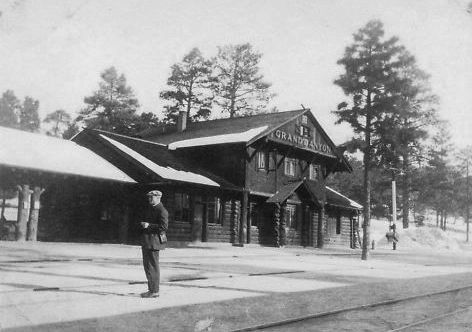
Grand Canyon Station, c1910
“Only by descending into the canyon may one arrive at anything like comprehension of its proportions, and the descent cannot be too urgently commended to every visitor who is sufficiently robust to bear a reasonable amount of fatigue. . . . For the first two miles it is a sort of Jacob’s ladder, zigzagging at an unrelenting pitch. At the end of two miles a comparatively gentle slope is reached, some 2500 feet below the rim, that is to say - for such figures have to be impressed objectively on the mind - five times the height of St. Peter’s, the Pyramid of Cheops, or the Strasburg Cathedral. . . . Looking back from this level the huge picturesque towers that border the rim shrink to pigmies, and seem to crown a perpendicular wall, unattainably far in the sky. Yet less than one-half the descent has been made.
“Overshadowed by sandstone of chocolate hue, the way grows gloomy and foreboding, and the gorge narrows. The traveller stops a moment beneath a slanting cliff 500 feet high, where there is an Indian grave and pottery scattered about. A gigantic niche has been worn in the face of this cavernous cliff, which, in recognition of its fancied Egyptian character, was named the Temple of Seti by the painter Thomas Moran.
“A little beyond this temple it becomes necessary to abandon the animals. The river is still a mile and a half distant. The way narrows now to a mere notch, where two waggons could barely pass, and the granite begins to tower gloomily overhead. . . . Obstacles are encountered in the form of steep imposing crags, over which the pedestrian must clamber. After these lesser difficulties come sheer descents, which at present are passed by the aid of ropes.
"The last considerable drop is a 40-foot bit by the side of a pretty cascade, where there are just enough irregularities in the wall to give toe-hold. The narrowed cleft becomes exceedingly wayward in its course, turning abruptly to right and left, and working down into twilight depth. It is very still. At every turn one looks to see the embouchure upon the river, anticipating the sudden shock of the unintercepted roar of waters. When at last this is reached, over a final downward clamber, the traveller stands upon a sandy rift confronted by nearly vertical walls many hundred feet high, at whose base a black torrent pitches in a giddying onward slide that gives him momentarily the sensation of slipping into an abyss.” (1)
Such is the Grand Canyon of the Colorado, which this railway has made so accessible to the world. The Colorado is bridged in but two places - at Green River Station for the Union Pacific track, and at Needles, 400 miles lower down, where the “A. T. & S. F.” passes over the Mojave Canyon on a huge cantilever bridge, the second largest of its kind in the world, into South California - the “ Land of the Afternoon”. This territory is crossed from north-west to south-east by the San Bernardino Range, which as sharply differentiates the climate of the countries on its two slopes as do the Himalayas. To the north lies the howling Mojave desert, arid, rocky, inhospitable, where only the cactus, grease-wood, and a few other hardy plants can grow - but a rich mineral field. On the south is one of the fairest gardens of the world, a veritable earthly paradise, where the summer sun and the moisture laden clouds of the Pacific and the irrigation canals combine to clothe the land with flowers and fruit trees in prodigal abundance. Who has not heard of the lemons and oranges of Los Angeles and Riverside - those seedless oranges famous all the world over? The fortunes of this citrus-growing district are so much bound up with those of the railways passing through, that, as in the case of the Grand Canyon, a digression will be pardonable to glance at the history of Riverside, which has, so to speak, grown out of oranges.
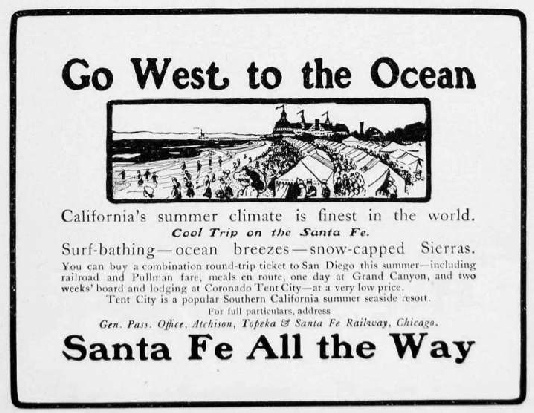 Previous to 1870 the site of this town of 10,000 inhabitants was simply a grazing ground for cattle, and a poor one at that, from lack of water. Then there came a small band of enterprising men, who pitched upon the place as likely, with proper irrigation, to produce heavy crops of oranges. Not discouraged by the ridicule of older settlers in the district, they dug their irrigation canals and planted their first orange seedlings, and when these proved a complete failure they tried growing lemons; and, disappointed here again, they cultivated raisins, with some success. But so much money had been spent that their finances were almost exhausted. In a lucky hour one of them received from Washington a couple of orange trees imported from Brazil. He planted the trees, which soon proved that they were as well suited to Riverside as the rabbit is to Australia. They produced fruit of great size and good quality, and, moreover, without the pips which detract somewhat from the pleasure of eating the ordinary orange. “Buds were taken from the trees and grafted on the stock of the ordinary orange trees grown from seedlings. This grafting was a complete success, and soon there were a number of trees in Riverside producing the seedless oranges. Then everybody there wanted buds for grafting purposes, and the fortunate owner of the parent trees netted a good sum of money by selling the buds at so much each. They were worth all they cost, however, for the oranges they produced became the most popular and the most profitable grown in the United States, and they were the foundation of that remarkable development in orange growing to which California has since attained. To-day there are something like 20,000 acres of orange groves in and around Riverside planted mainly with navel orange trees, the whole of those trees having been produced directly or indirectly from the two referred to above. The parents of so prodigious a family still survive, and are to be seen at the entrance to the famous Magnolia Avenue at Riverside.” (2)
Previous to 1870 the site of this town of 10,000 inhabitants was simply a grazing ground for cattle, and a poor one at that, from lack of water. Then there came a small band of enterprising men, who pitched upon the place as likely, with proper irrigation, to produce heavy crops of oranges. Not discouraged by the ridicule of older settlers in the district, they dug their irrigation canals and planted their first orange seedlings, and when these proved a complete failure they tried growing lemons; and, disappointed here again, they cultivated raisins, with some success. But so much money had been spent that their finances were almost exhausted. In a lucky hour one of them received from Washington a couple of orange trees imported from Brazil. He planted the trees, which soon proved that they were as well suited to Riverside as the rabbit is to Australia. They produced fruit of great size and good quality, and, moreover, without the pips which detract somewhat from the pleasure of eating the ordinary orange. “Buds were taken from the trees and grafted on the stock of the ordinary orange trees grown from seedlings. This grafting was a complete success, and soon there were a number of trees in Riverside producing the seedless oranges. Then everybody there wanted buds for grafting purposes, and the fortunate owner of the parent trees netted a good sum of money by selling the buds at so much each. They were worth all they cost, however, for the oranges they produced became the most popular and the most profitable grown in the United States, and they were the foundation of that remarkable development in orange growing to which California has since attained. To-day there are something like 20,000 acres of orange groves in and around Riverside planted mainly with navel orange trees, the whole of those trees having been produced directly or indirectly from the two referred to above. The parents of so prodigious a family still survive, and are to be seen at the entrance to the famous Magnolia Avenue at Riverside.” (2)
For many years Riverside supplied half of the total orange crop of Southern California; even now it grows one-third. Orange culture has been made a fine art. Cement-lined canals lead water through the orchards, which are irrigated at regular intervals all the year round. The farmer tends his trees with the utmost care, even lighting bonfires to warm the groves when the temperature falls to near freezing-point. During the winter months whites and Japanese pick the fruit and carry it to the packinghouse, where it is cleaned, graded, enveloped in tissue-paper wrappers, and packed into cases.
Now we come back to our main theme - the railroad. Without the means of distributing quickly so perishable a commodity as fruit, the orchards of California would never have grown and prospered; and but for the immense quantities of Californian fruit that they handle, the southern railways across the continent could hardly pay their way. In 1901 from the Los Angeles district alone, 18,000 carloads (each carload 10 to 15 tons) of oranges and lemons were sent eastwards over the Santa Fe, Southern Pacific, and other systems for an average distance of 2000 miles. Add to this 325,000,000 lbs of dried fruit; 1,400,000 boxes of apples; 80,500 tons of canned goods; and 12,000 carloads of walnuts, vegetables, sugar, wine, &c., and you will begin to understand what effect these railways have upon the commissariat of the United States. It is a very common sight to see trains of forty waggons puffing across the plains and through the mountains with vegetables for the cities of the Eastern States; while from the Los Angeles neighbourhood 200 truckloads of oranges are despatched daily throughout the picking season. We may well doubt whether even the sanguine Colonel Holliday took the full measure of California when he fought so hard for the laying of the Santa Fe track.
(1) Since this account was written the facilities for a descent have been much improved
(2) The Times, April 13, 1903
[From The Romance of Modern Locomotion by Archibald Williams, c1920]
You can read more on “North American Railroads”, “The Pennsylvania Railroad”, “The Santa Fe Chief” and “The Union Pacific Railway” on this website.







 Previous to 1870 the site of this town of 10,000 inhabitants was simply a grazing ground for cattle, and a poor one at that, from lack of water. Then there came a small band of enterprising men, who pitched upon the place as likely, with proper irrigation, to produce heavy crops of oranges. Not discouraged by the ridicule of older settlers in the district, they dug their irrigation canals and planted their first orange seedlings, and when these proved a complete failure they tried growing lemons; and, disappointed here again, they cultivated raisins, with some success. But so much money had been spent that their finances were almost exhausted. In a lucky hour one of them received from Washington a couple of orange trees imported from Brazil. He planted the trees, which soon proved that they were as well suited to Riverside as the rabbit is to Australia. They produced fruit of great size and good quality, and, moreover, without the pips which detract somewhat from the pleasure of eating the ordinary orange. “Buds were taken from the trees and grafted on the stock of the ordinary orange trees grown from seedlings. This grafting was a complete success, and soon there were a number of trees in Riverside producing the seedless oranges. Then everybody there wanted buds for grafting purposes, and the fortunate owner of the parent trees netted a good sum of money by selling the buds at so much each. They were worth all they cost, however, for the oranges they produced became the most popular and the most profitable grown in the United States, and they were the foundation of that remarkable development in orange growing to which California has since attained. To-
Previous to 1870 the site of this town of 10,000 inhabitants was simply a grazing ground for cattle, and a poor one at that, from lack of water. Then there came a small band of enterprising men, who pitched upon the place as likely, with proper irrigation, to produce heavy crops of oranges. Not discouraged by the ridicule of older settlers in the district, they dug their irrigation canals and planted their first orange seedlings, and when these proved a complete failure they tried growing lemons; and, disappointed here again, they cultivated raisins, with some success. But so much money had been spent that their finances were almost exhausted. In a lucky hour one of them received from Washington a couple of orange trees imported from Brazil. He planted the trees, which soon proved that they were as well suited to Riverside as the rabbit is to Australia. They produced fruit of great size and good quality, and, moreover, without the pips which detract somewhat from the pleasure of eating the ordinary orange. “Buds were taken from the trees and grafted on the stock of the ordinary orange trees grown from seedlings. This grafting was a complete success, and soon there were a number of trees in Riverside producing the seedless oranges. Then everybody there wanted buds for grafting purposes, and the fortunate owner of the parent trees netted a good sum of money by selling the buds at so much each. They were worth all they cost, however, for the oranges they produced became the most popular and the most profitable grown in the United States, and they were the foundation of that remarkable development in orange growing to which California has since attained. To-